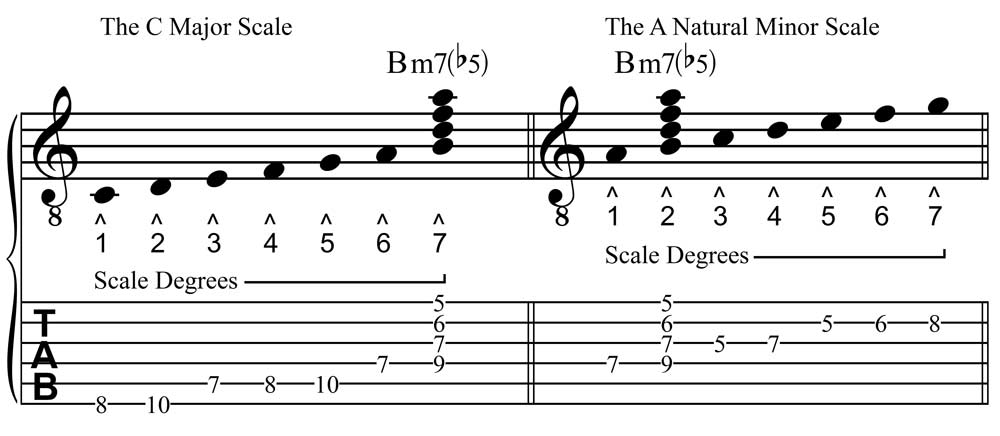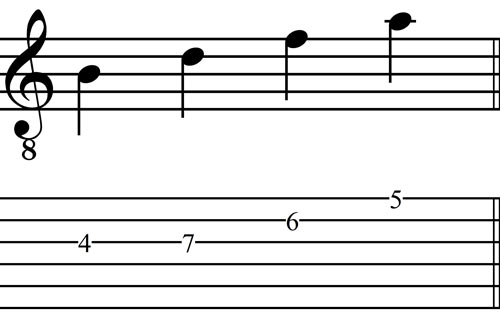How to Solo Over Minor Seventh Flat-Five
(Half-Diminished Seventh) Chords
Part One: Basic Theory and Arpeggiation
(click here for part two)
1. Basic Theory
The minor seventh flat-five chord (also called the half-diminished seventh chord - click here for an article about this) usually occurs on the seventh degree in major keys and the second degree in minor keys. (Scale degrees are the notes of the scale. The first note of a scale is the first scale degree, the second note of the scale is the second scale degree, etc.) Knowing that this chord occurs in these two common ways will help us explore some good scales to use in part two of this web series.The examples below show how this chord appears in the keys of C major and A minor.

Shown below is some basic information about the Bm7b5 chord, including its four members: root, 3rd, 5th, and 7th. The first example shows it in root position (the note B - the "root" - is on the bottom) with the other three notes of the chord - 3rd, 5th, and 7th - squeezed in tightly above it. This is called "close position". If you try to play this chord on the guitar, you'll notice that it's quite a stretch for the fretting hand. That's why guitar players often rearrange the notes of the chord in a fashion that makes it easier to play. Often this involves placing some notes higher or lower than in close position. You could say that we're putting some air between the notes to create a cushion. Putting space in a chord in this way is called "open position".

2. Arpeggiate the Chord
One of the easiest ways to improvise over this chord is to arpeggiate it - play the notes of the chord in some sort of succession. In the examples below, a Bm7b5 chord is used because it contains no flats or sharps. This is the simplest way to cut one's teeth when starting to improvise on this sometimes troubling chord.
The first example shows a simple ascending arpeggio using the notes of a Bm7b5 chord in succession from the root through the seventh.

The next three examples vary the arpeggio slightly, first by descending, then by changing the order the notes are played.

More complicated arpeggios can be constructed by extending the range (using the same four members - B, D, F, and A - in higher or lower octaves) and using eighth-note rhythms.

Very complicated arpeggios are possible using variations on the techniques explored above. I hope I have given you the tools to start constructing your own arpeggios. Next, in part two of this web series, I will discuss using scales to improvise over the minor seventh flat-five chord. Click here to see it.
Jeff Anvinson, owner/operator of JLA Music
Website and most graphics are created inhouse by Jeff Anvinson, Owner/Operator of JLA Music
Some graphics are purchased from Can Stock Photo, used by permission, and are Copyright
© Can Stock Photo
JLA Music takes care not to infringe on anyone's rights. Please contact us at jla@jlamusic.com if you have questions.
Copyright 2025 © Jeff Anvinson, JLA Music


